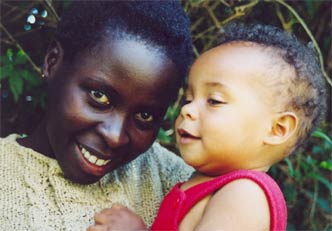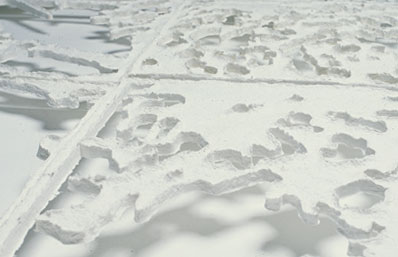|
|
|
| ||
| EspaŮol |
Currently only excerpts & illustrations from the last 13 issues (numbers 43 to 55) are on this site. Scroll down to view the June 1999 issue. Click on the numbers to view other issues. Info about the current book on the arts | |||||||||||||||||||||||||||||||||||||||||||||||
| Contents List | |||||||||||||||||||||||||||||||||||||||||||||||
| excerpts & illustrations (The full articles are only available in the printed magazine. Click on "subscribe" for more info.) |
 |
56 |  |
55 |  |
54 |  |
 |  |
53 |  | 52 |  |
51 |  |
 |
 |
50 |  |
49 |  |
48 |  |
47 |  |
 |  |  |  |
 | ||||||||||||||||||
 |
 |  |
 | ||||||||||||||||||||||||||||||||||||||||||||
| 46 |  |
45 |  | 44 |  |
43 |  |  |
 | 42 |  | 41 |  | 40 |  | 39 |  |
 | 38 |  | 37 |  |
36 |  | 35 |  |
 |  |
34 |  |
33 |  | 32 |  | 31 |  | |||||||||||
|
 Magister Ludi, theatre project in Bolzano, Italy, by Roberto Lun, 1999. Video projections of drawings by Jacqueline Wassen (The Netherlands) were projected on the titled table surface while four actors performed around the table. |
June 1999
|
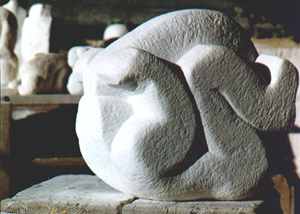
Sculpture in Carrara marble, 1998, by Caroline Ruizeveld, The Netherlands. |
Caroline Ruizeveld, (The Netherlands) Last summer I worked in a studio for three months sculpting marble in PietraSanta in Northern Italy. This area is where the world famous Carrara marble comes from. Michelangelo and Henry Moore have also sculpted in this area. I started sculpting in stone at the end of 1997 having decided to devote myself to becoming a sculptor. Since then I have travelled to places such as Zimbabwe, where there is a strong sculpting tradition, to learn as much as I can. The Italian marble is harder than the Opal stone of Zimbabwe and the method of working it was also different. |
|
In Zimbabwe I used the
rough -natural- form of the stone to influence to the forms I sculpted which tended to be figurative.
Here in Italy I was confronted with a formless sawn-off block of marble...
Please contact me via Arts Dialogue about any residency possibilities in your part of the world. 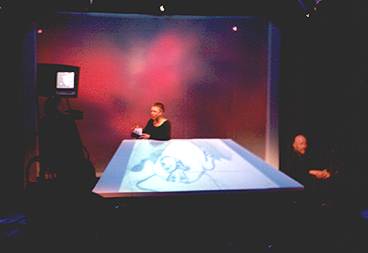 Jacqueline Wassen Jacqueline Wassen (The Netherlands) Recently I participated in a theatre project in Bolzano, Italy. Magister Ludi, loosely based on short stories by the Swiss writer, Peter Bichsel, and directed by Roberto Lun, was a theatre of stories around a large table. My task was to make illustrations of the stories.... ...The projected illustrations, often styllized figurative references to the texts, reinforced the force of the words spoken by the actors... ...At the premiere the actors left the differences and difficulties that had continually surfaced behind, and now performed with such clarity that it seemed as if a whole new work of art had been created. Something had been achieved and everyone felt this. Using the medium of telling stories -where voices refused to tell the truth, only about the possibilities of truth-, Roberto Lun created links between the intellectual and the emotional spirit of the body. One actor danced, another remained in his wheelchair with a television image of his face above his head, and the two others continuously gestured around the table. The music was composed and performed by the local band, N-Venus. Reviews
pages 5 - 6
|

Workshop coordinated by the European Bahá´í Youth Council | The Hague Appeal for Peace conference, May 99. |
| over this millennium we have seen how culture can be a powerful mobilizing tool to increase awareness,
encourage debate and even change significant realities. Our idea is to offer a sampler of music, art, dance and film from
many different countries: an inextricable mixture of activities that explore the innovative ways in which the arts
contribute towards a culture of peace. (p. 57) There were approximately ten arts events on each of the 5 days. Some were... ...the 90 minute play, The Road Home performed by the New York, River Arts Repertory and John Burt... ...The actors, either victims of war themselves, such as Yolanda King (the daughter of Martin Luther King) or actively involved in the peace movement, told the stories of children of war using a wide range of acting techniques. They were so convincing that you didnít know if the character was really the victim or an actor or at times whose personal story it was. The scenarios were accompanied by live music, performed by one of Tibetís foremost world composer/musicians, Nawang Khechog, (himself a child survivor of war) and by huge photo and video projections. This performance told stories of children of war as well as giving us a glimpse of their culture through potent yet minimal images and text... ...This theatre provided a means for removing a silence caused by intolerance and ignorance... ...Awake a Dutch Bahá´í dance group of teenagers also performed, sponsored by the European Bahá´í Youth Council. There were a range of musicians performing... | |||||||||||||||||||||||||||||||||||||||||||||||
Artist Profilespages 6 - 7 Ben Roberts, actor / theatre director, U.S.A. Interview with Sonja van Kerkhoff, The Netherlands. I´m pretending Iím living in Kiev and saving up my paycheck for months until I have enough money for an Arch Deluxe. My salary isn´t keeping up with inflation, there aren´t enough jobs anyway, the food and water is suspect ever since the Chernobyl plant blew up, and the future looks lousy. So why are those Americans |
 Ben Roberts performing, A Clown, A Hammer, A Bomb and God at The Hague Appeal for Peace, May 1999. |
| spending all the treasures of the world to threaten me? Why are they still pointing missiles at me? If I were living in Kiev, I´d personalize it. Iíd start saying
´Whatís wrong with these people?´. I´m ten feet away from the silo that holds the death sentence for everyone
within thirty miles of Kiev. None of us want that missile to fly over and blow up the city of Kiev. Do we? I said, DO WE?
Well, your name is on the missile. And so is mine. It says US right on it. If you´ve been paying taxes and living in
the confines of the law, you can´t pretend you didnít think the missile going off over Kiev was a good idea. You canít even
pretend, the way the German civilians did after World War II, that you didn´t know what your government was doing in
your name. Even if you don´t read papers or watch television, you can´t say you didn´t know anymore. I TOLD YOU.
After today, you´ll never be able to say you didn´t know. You´re welcome.
Text from the play, A Clown, A Hammer, A Bomb and God written by Daniel Kinch and performed by Ben Roberts. "I tell people that the only two playwrights I work with are Dan and Shakespeare, and Shakespeare wonít return my calls! The work I do with Dan, which involves co-directing and co-producing, as much as performing on stage, is issue-oriented, faith-based, often comedic, and always political. I live in New York City. I was waiting tables, doing the odd acting jobs, going to the right acting classes, doing all the networking stuff to get casting directors to take notice of me, and was getting sick of the rat race way of living. Then in 1996, I met Dan. Danīs work not only appealed to me because of the subject matter but also because of the way we worked together." During the 7-8 years prior to that, Ben was associate director with Kim Johnson, who was the artistic director, in a theatre called Artists In Search of... Inc. They gave free acting classes to teenagers on Saturdays for 8-10 week sessions, which ended with them putting on a show... |
|
pages 7 - 9 Alison Vardy, harpist, Canada. I think that there´s probably a musical instrument that best fits each one of us. I feel very lucky that I found my fit, even though it wasn't until I reached my thirties. My parents provided me with piano lessons for many years and this training was of immense practical support in my self-directed study of the folk harp. I enjoy practising, and if I don't, I leave it for another day. My most intense joys in music have been when playing |
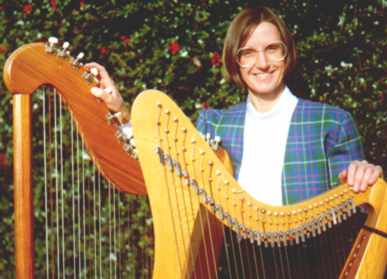 Alison Vardy, 1998, Canada. | ||||||||||||||||||||||||||||||||||||||||||||||
| for myself and discovering new melodies, harmonies and rhythmic patterns.
Then there's the fun of sharing it! Now, when I teach others I'm facilitating, encouraging and hopefully inspiring, as much as instructing. The capacity to learn is already there...it's just the will to apply it. The bottom line is enjoying the process of learning and playing the harp (or whatever instrument) for there's no end-point where you can say "There, I´ve made it." Good thing there isn´t; I would have lost motivation long ago... You can hear clips from her CD, Harping On at: http://www.canadiana.bc.ca/harp.htm | |||||||||||||||||||||||||||||||||||||||||||||||
Poems
from their big houses |
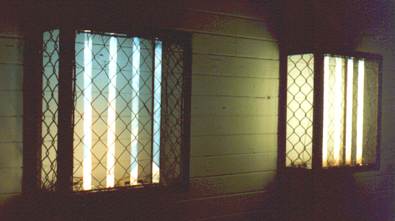 Untitled 1996 by Tom van Teijlingen light sculpture The Netherlands | ||||||||||||||||||||||||||||||||||||||||||||
being nice. What was the evening lineExcerpts from the novel, The Island of the Same Name
by Joseph Sheppherd, U.S.A. |
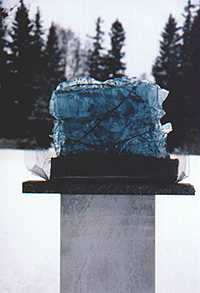 Wound, 1992 by Mary Gregory glass sculpture, Finland. This was made in response to the atrocities occuring in Saravego.  The Cell of Akka, ceramic by Chris Clay, basketry by Suzette Nyokka, U.S.A. | ||||||||||||||||||||||||||||||||||||||||||||||
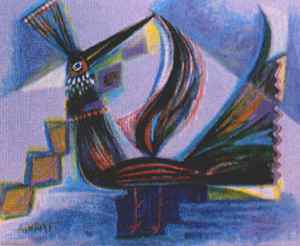
|
I - The Distant Past As the legend predicted, the future homeland of his people would have to be unnamed, a new place, not an old place won from another tribe in battle. To the boy the word ´unnamed´ meant uninhabited, but he knew he could be wrong. Approaching the island, it was certainly unnamed to him. It was an unknown place, as nameless as an unmet stranger. With this thought, Small-Seafarer hoped that it was after all, uninhabited, without strangers. The clouds had begun to clear and it was time to lower the raffia sail and secure the sail-pole to the side of the boat. Small-Seafarer watched the black silhouette of the high peaks |
|
against the fleeting clouds and said the name quietly, with
the humility one shows to an elder. ´Abode-Haven´ he whispered, calling to the island. In the silence, the boy waited for the island to answer in his heart. As with all things greater than himself, he knew that a superior could choose when or if to answer. In a moment of panic, he supposed that this wasnít the island. Perhaps he had gone astray in the night and perhaps this island didnít recognize the name. He reassured himself that he had followed the Oracle-Fatherís instructions correctly. It really didnít matter now, the time would soon come to land the boat and find out if there was an answer waiting for him. He had listened well to the old stories the Oracle-Father had told. He knew them by heart and he knew what to look for. Abode-Haven was a feeling, a scene viewed with more than just sight. Thinking about it Small-Seafarer decided that even if it were the future safe homeland of his people, Abode-Haven would not be good name for it. After all, Abode-Haven was similar to the name Peace, a name without a place.... |
Article
pages 14 - 15
|
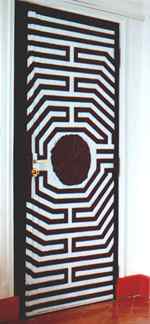 Labyrinth painted on a French castle door, by Hervé Constant, U.K. |
Hervé Constant, U.K., Myriam Bargetze, Lichtenstein,
Mary Gregory, Finland, Jacques Paratian, France,
Olesya Tsutskova, Russia, Jacqueline Wassen, The Netherlands,
Sophie Lampkin, France, Tom van Teijlingen, The Netherlands., Ilmara Blumberga, Latvia, George Fleming, Northern Ireland,
Ruth Park, Australia, Martin de Wit, The Netherlands, Keike Twisselmann, Northern Ireland, Paul Aarts, New Zealand.
|

Time Moves On 1990, oil on canvas by George Fleming, Northern Ireland. In the catalogue, Beyond the Partitions, Queen Street Studios, Belfast. |
Translations, editing, layout, by:Kathleen Babb, Japan, Alison Marshall, Aotearoa / New Zealand,
Steve Marshall, Aotearoa / New Zealand, Sonja van Kerkhoff, The Netherlands. |
|
Arts Dialogue, Dintel 20, NL 7333 MC, Apeldoorn, The Netherlands.
http://Bahá´í-library.org/bafa email: bafa@bahai-library.com |
